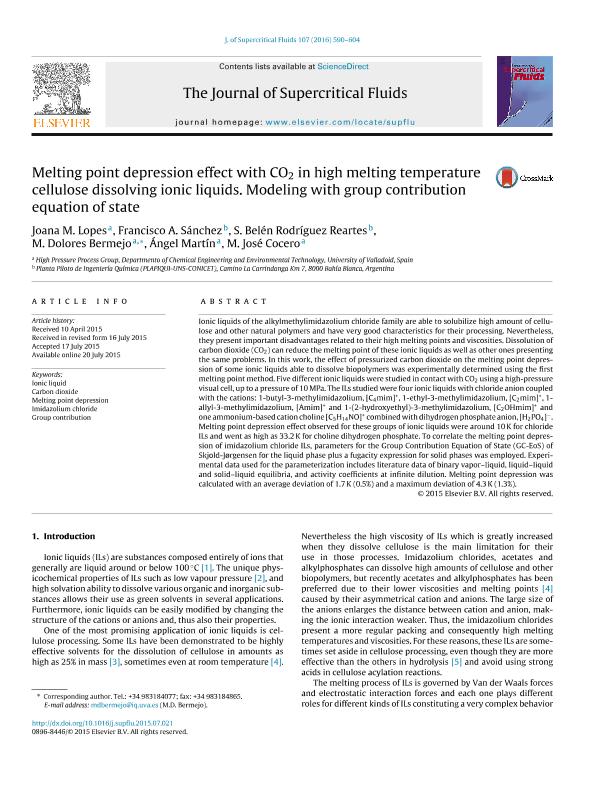Artículo
Melting point depression effect with CO2 in high melting temperature cellulose dissolving ionic liquids: Modeling with group contribution equation of state
Lopes, Joana M.; Sánchez, Francisco Adrián ; Rodriguez Reartes, Sabrina Belen
; Rodriguez Reartes, Sabrina Belen ; Bermejo, M. Dolores; Martín, Ángel; Cocero, María José
; Bermejo, M. Dolores; Martín, Ángel; Cocero, María José
 ; Rodriguez Reartes, Sabrina Belen
; Rodriguez Reartes, Sabrina Belen ; Bermejo, M. Dolores; Martín, Ángel; Cocero, María José
; Bermejo, M. Dolores; Martín, Ángel; Cocero, María José
Fecha de publicación:
20/07/2015
Editorial:
Elsevier Science
Revista:
Journal of Supercritical Fluids
ISSN:
0896-8446
Idioma:
Inglés
Tipo de recurso:
Artículo publicado
Clasificación temática:
Resumen
Ionic liquids of the alkylmethylimidazolium chloride family are able to solubilize high amount of cellulose and other natural polymers and have very good characteristics for their processing. Nevertheless, they present important disadvantages related to their high melting points and viscosities. Dissolution of carbon dioxide (CO2) can reduce the melting point of these ionic liquids as well as other ones presenting the same problems. In this work, the effect of pressurized carbon dioxide on the melting point depression of some ionic liquids able to dissolve biopolymers was experimentally determined using the first melting point method. Five different ionic liquids were studied in contact with CO2 using a high-pressure visual cell, up to a pressure of 10 MPa. The ILs studied were four ionic liquids with chloride anion coupled with the cations: 1-butyl-3-methylimidazolium, [C4mim]+, 1-ethyl-3-methylimidazolium, [C2mim]+, 1- allyl-3-methylimidazolium, [Amim]+ and 1-(2-hydroxyethyl)-3-methylimidazolium, [C2OHmim]+ and one ammonium-based cation choline [C5H14NO]+ combined with dihydrogen phosphate anion,[H2PO4]−. Melting point depression effect observed for these groups of ionic liquids were around 10K for chloride ILs and went as high as 33.2K for choline dihydrogen phosphate. To correlate the melting point depression of imidazolium chloride ILs, parameters for the Group Contribution Equation of State (GC-EoS) of Skjold-Jørgensen for the liquid phase plus a fugacity expression for solid phases was employed. Experimental data used for the parameterization includes literature data of binary vapor–liquid, liquid–liquid and solid–liquid equilibria, and activity coefficients at infinite dilution. Melting point depression was calculated with an average deviation of 1.7K (0.5%) and a maximum deviation of 4.3K (1.3%).
Archivos asociados
Licencia
Identificadores
Colecciones
Articulos(PLAPIQUI)
Articulos de PLANTA PILOTO DE INGENIERIA QUIMICA (I)
Articulos de PLANTA PILOTO DE INGENIERIA QUIMICA (I)
Citación
Lopes, Joana M.; Sánchez, Francisco Adrián; Rodriguez Reartes, Sabrina Belen; Bermejo, M. Dolores; Martín, Ángel; et al.; Melting point depression effect with CO2 in high melting temperature cellulose dissolving ionic liquids: Modeling with group contribution equation of state; Elsevier Science; Journal of Supercritical Fluids; 107; 20-7-2015; 590-604
Compartir
Altmétricas



